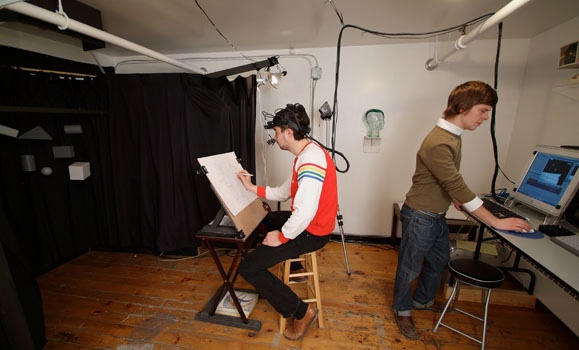If youÔÇÖve ever taken a drawing class, you may recall the instructor telling you to squint while looking at the scene in front of you ÔÇö the theory being that squinting takes away some of the details and colour information and allows you to see values and shapes more easily.
ThatÔÇÖs the thinking, but is it true? And if so, why? Those are some of the questions that the NSCAD University Drawing Lab has endeavoured to answer through its research.
The NSCAD University Drawing Lab is a NSCAD-H┬■╗ş collaborative research group with Bryan Maycock and Mathew Reichertz from NSCAD and Raymond Klein and John Christie from H┬■╗ş. Jack Wong is the eminently qualified lab manager and research assistant; he has a fine arts degree from NSCAD and an engineering degree from UBC.
The lab was officially launched in 2005 with funding by the Social Sciences and Humanities Research Council (SSHRC). Now in its third home (NSCADÔÇÖs Academy Building) and on its second SSHRC grant ($157,000 for three years) the lab seeks a better understanding of the artistic process through the application of scientific methods.
The "art" of the matter
The subjects for exploration have arisen out of teaching drawing classes at NSCAD and a questioning of why common practises used by drawing instructors seem to work in terms of getting students to be better at drawing. Like the tip about squinting, for example, or the exercise of drawing a scene illuminated by a strong light from one side instead of a diffuse light from overhead.
ÔÇťWe do these things, but why? WhatÔÇÖs the evidence?ÔÇŁ says Prof. Reichertz, chair of the Fine Arts Division at NSCAD. ÔÇťThatÔÇÖs what this lab endeavours to find out.ÔÇŁ
One of its first studies was to analyze how experienced artists drew as compared to foundation-level students. One of its conclusions ÔÇö research is still ongoing using the wealth of data gathered ÔÇö is that students quickly improved at drawing with practice; like the experienced artists, they began to look at what they were drawing more and less at their drawing. In September, the lab will begin work on a new, more open-ended study about the possible benefits of using digital drawing tablets to teach drawing. The lab also hopes to engage masterÔÇÖs students in conducting research.
ÔÇťWe are people who work well together,ÔÇŁ says Dr. Klein, professor and cognitive psychologist in Dal's Department of Psychology and Neuroscience, about the NSCAD-H┬■╗ş collaboration. ÔÇťThe key for us is in being open minded and allowing ourselves to be exposed to different ways of thinking.ÔÇŁ

